Opening Range Breakout (ORB) Strategy - Rules, Settings & Trade Examples
A Detailed Guide to Mastering the Opening Range Breakout
Home » Opening Range Breakout (ORB) Strategy – Rules, Settings & Trade Examples


Opening Range Breakout Strategy
In this article I’m going to do a deep dive into the opening range breakout (otherwise known as the orb strategy) I’ll give you my opinion and thoughts on the strategy as a whole.
Then you can make an informed decision as a day trader whether you want to add the opening range setup to your trading playbook. Or not…
I’ll cover important trade setup aspects like:
- What exactly is the opening range breakout?
- When might you use the opening range breakout strategy?
- The ORB setup rules
- 5 vs 15 minute opening range
- Stop loss and target parameters
- Risk management and more...


I’ve also included a copy of a trading webinar I was asked to present covering the orb strategy in more detail.
Let’s begin…
Contents (tight on time? skip to your chosen section)
What is the Opening Range Breakout Strategy?


Firstly, let’s just get a grip on what the heck the ORB is…
The Opening Range Breakout (ORB) is a day trading strategy that involves buying or selling after the “opening range” of a trading day has been established, with the aim to capitalise on the emerging trend.
The opening range is subjective, (more on that later) but typically defined as the first 5, 10, 15 or 30 minutes of trading.
(And unlike some other trading strategies, the opening range breakout has risk management basically built in. There’s no ambiguity for the stop. If price breaks back in the other direction and it’s a false breakout, you’re out.)
The whole objective for us as day traders is to identify when a trading session could possibly have a persistent trend day and then use the opening range breakout play to trigger a trade entry early on in the day…
But as always in trading, the key is in the timing.
The Opening Range Breakout Trade
If you want to skip the text and prefer watching a video, then this webinar I hosted for UK broker Pepperstone covers the ORB in detail.
Pros and Cons of The Opening Range Breakout
ORB Upsides
- Simple trading rules
- Clearly defined stop loss
- Requires little screen time to trade
ORB Downsides
- Can be late to enter if the open is explosive
- Stop can be wide
- Poor performance on range days
The ORB rules are quite simple, but to really get the most of it, knowing when to deploy the trade setup is key. Or you can get whipped with false breakouts.
Toby Crabel - The Opening Range Breakout Strategy Pioneer.
Let me digress slightly and tell you a little story about Toby Crabel… the ORB OG.
Crabel runs Crabel Capital a hedge fund with around $8.5 Billion of assets under management.
He started his career working on the ORB and did a lot of work improving on Wyckoff’s research
Like any good trader, he viewed the orb strategy through his own lens and made it his own.
Crabel noticed that the opening range could often indicate the market direction for the next few hours, trading day and even potentially a multi-day move depending on market conditions.


Narrow Range 7 - A Way To Gauge Market Sentiment
One of Crabel’s discoveries when conducting market analysis was that he found the opening range breakout trade to be most effective after a Narrow Range 7 (NR7) day – a day where the range is the narrowest of the last seven days. This often precedes a breakout or trend day.
So adding a screening filter that says “I will only trade the ORB after an NR7 day” can give you a better chance of getting on board a trend day. (DYOR here as always)


Day Trading With Short Term Price Patterns And Opening Range Breakout Strategy
Crabel documented all his findings and research in a book called. Day Trading With Short Term Price Patterns And Opening Range Breakout.
He published it, and the book was a success!
But Crabel didn’t want his ‘trading secrets’ in the public domain so allegedly bought back all the books. He then went on to create a hedge fund (Crabel Capital) which is currently thriving.
Occasionally you see rogue copies of this book available for thousands of dollars.
I’m lucky enough to have one… mainly because I’m a total markets and trading nerd!
The point of that short story was to show you that the opening range breakout is a very useful trading strategy, but when to deploy it (after NR7 for example) is key.
Back to the topic!


Opening Range Breakout Strategy Rules and Parameters
The rules of the ORB strategy are clear and systematic, focusing on bracketing the ‘open’.
For instance, if the high in the first 15 minutes was $112.5 and the low was $110.75, a trader would go short (sell) after 15 minutes if the price breaks below $110.75, or take a long entry (buy) if price breaks above $112.5.
The strategy has various parameters that can be tweaked, such as the time of the opening range, allowance for additional tick buffer outside of the range before entering a trade, and the specific time for entering a trade. (5, 15, 30, 60 minutes)
One approach to reduce false breakouts is to filter by daily chart patterns and apply the ORB strategy on a daily chart that aligns with the market theme…
This could include anticipating a breakout, identifying the lower end of an uptrend channel, or considering earnings and catalysts.
In other words, you wait for the daily chart to look bullish and only then trade the ORB on the long side. Whilst it’s in no mans land you do not trade the ORB.
Many traders (especially retail traders) trade opening range breakout, simply because it has
- Clear price direction,
- Simple profit targets,
- Fixed risk management rules.
This makes the decision-making process super simple!
You’re not doing any fancy volume analysis; it doesn’t matter if you get overnight news, you aren’t really even trying to read price action.
It’s just a simple trading plan, executed at fixed price levels in the opening minutes of your chosen market. Whether that’s futures contracts, CFDs or stocks.


15 minute opening range breakout strategy
Using 15 minutes as your opening range is a good place to start for many traders. It’s short enough not to have a huge range play out, yet long enough to avoid the market noise.
Let’s look at an example…
Trading strategy rules for TESLA
- Bracket the opening 15m range
- Trigger a long entry if price breaks above $464.52
- Trigger a short entry if price breaks below $453.88
- In this example the long triggered
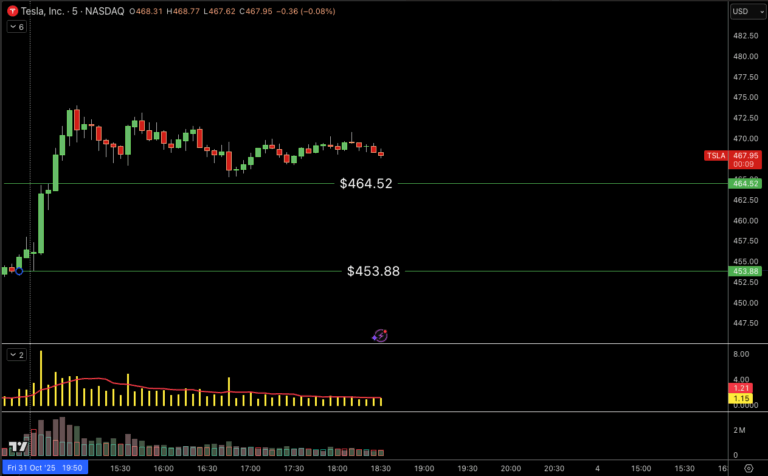

5 minute opening range breakout strategy
Using 5 minutes is much more aggressive; you are potentially getting a better trade entry on the trend day, but at the cost of getting more chopped up with false signals from the market.
Trading strategy rules for 5 min ORB
- Bracket the opening 5 minute range
- Trigger a long entry if price breaks above $457.51
- Trigger a short entry if price breaks under $453.88
- Same chart - but the trigger was sooner with the 5m range
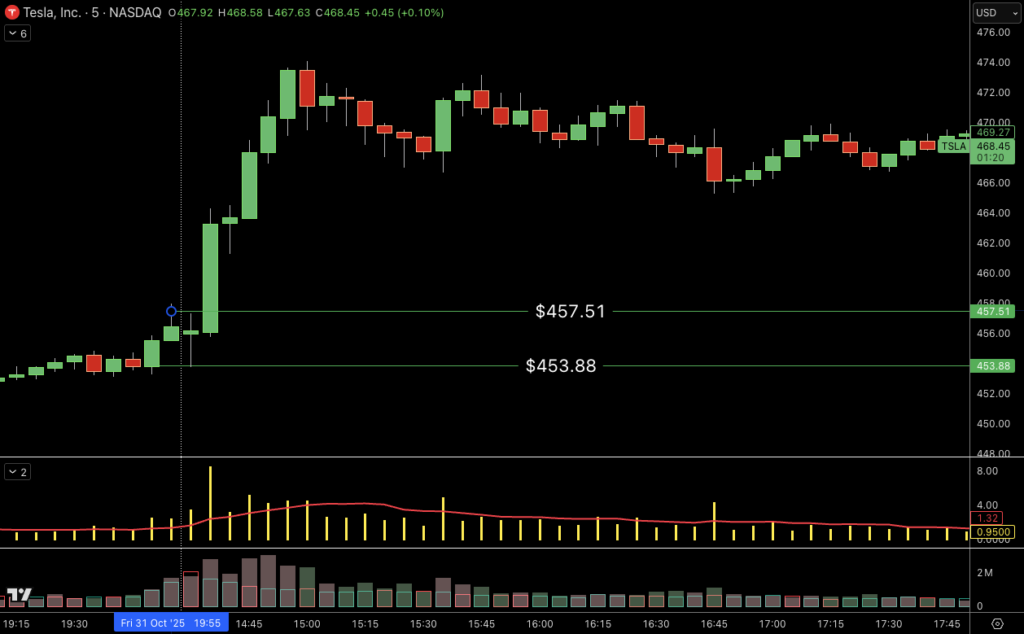

Opening Range Breakout Stop Loss
The beauty of the ORB for traders is that the trigger entry is very systematic, as is the stop loss criteria.
Basic rules state placing a stop under the low of the opening range for a long trade, or high for a short trade. (So in the Tesla example above, a long trade stop would be just under $453.88)
This is a great place to start if you are trying to capture a big trend day. (A slightly wider stop gives you more room to breathe)
If you aren’t looking for a whole day move, then a % of the opening range may better suit.


Opening Range Breakout Targets
Trade targets are one of those exit strategy variables you can tweak and adjust to suit your trading style and particular trade objective.
I wish I could give you some certainty here, but there really isn’t a one-size-fits-all.
For example, if you are aiming for a higher win rate at the cost of missing out on a potential big trend day you could set your targets at an RvR of 1.
Eg: If your range is 75pts then your target would be a fixed 75pts. Giving you a risk of 75pts x Your position and your reward is the same.
If your main objective is to capture big moves, then you would likey have a wider target, or hold until the close of the day.
The downside of this is that you will take more losses, so your % win rate will be lower. But when you do get one, it will be a big mover.
There’s no right or wrong with this. Mould the trading strategy to suit your style.
- Looking for more wins but less RvR? Use a closer target
- Looking for higher RvR but fewer wins? Use extended targets.
Small targets
- Use a fixed RvR of 1:1 or 2:1
- Scale a portion at 1:1, then 2:1, 3:1 etc
- Trail a stop equal to the range distance


Larger targets
- Hold until end of the day
- Hold for a multi day momentum move
- Look for 10:1+
Improving the opening range breakout strategy for different market conditions.
The key to really getting the most of this strategy is to be very strict when you deploy it.
ORB rules are simple, yes, but if you take them every day on every market, you will get hammered by choppy markets.
Creating a clear filter process to only play the opening range break on the best days will improve its success rate massively.
This is where trading intuition comes into play… the trade itself is a mechanical trigger (buy a breakout), but the market you choose to trade is up to you.


How do you select your market?
One nice way to take this play is to screen by daily chart pattern, use technical analysis and only take the ORB on a daily chart that aligns with the direction of the ORB trigger:
eg: Price about to breakout on the daily chart to the upside? You’d consider long only ORBs intraday.


Do you have a directional bias?
Another smart filter is to only position in the direction you believe has the most momentum.
So, identify or search for a market that has a strong daily chart bias before the open.
Then watch price action, and simply wait for your market to form the range. Then position in alignment with the higher timeframe when you get a trigger.
Let’s dissect an example. Our market is DAX…
DAX Opening Range Breakout
Imagine you’re a DAX trader and you’ve studied the daily chart. You see that price has closed the day strong, right at the top of the multi day range on the daily chart.
So the next day you want to align long only and use the opening range breakout method to get long.
DAX Opening Range Day Trading
Daily chart strong. Decent volatility. Price breaking the previous days high and closing at highs.
Prime for a breakout. You can now play the next day with more confidence that you are aligning with the higher time frame sentiment.
Many traders miss this but I think it’s really important to assess price from this relevant time frame.


Intraday DAX day trading - opening range
Next day, price makes a large opening drive.
As you are already prepared from your daily chart, you’d enter long on a 15 minute opening range price breakout candle in the same direction as the drive.
Price action is super strong, and after the market opens, the initial move is a one way street.
The opening range low is never even tested!
If you can identify this before the trading session you have already done the hard work. You have a defined entry, defined risk, clear exit points.


(High-volume price moves from the market open in one direction often indicate nice momentum, low prices are often never revisited)
Day Trading the Opening Range Strategy
Day trading is about rhythm, not randomness…
Good traders monitor the market for moments of imbalance, times when price movements give clues to potential future direction.
That first burst of volume in the initial minutes after the open often sets the tone for the entire session… if you know how to read it. Watch your resistance levels, your volume spikes and stick to your ORB playbook.
Avoid low-volume days, and of course, always use a stop loss… (I see too many aspiring traders forgetting this, live to fight another day!)
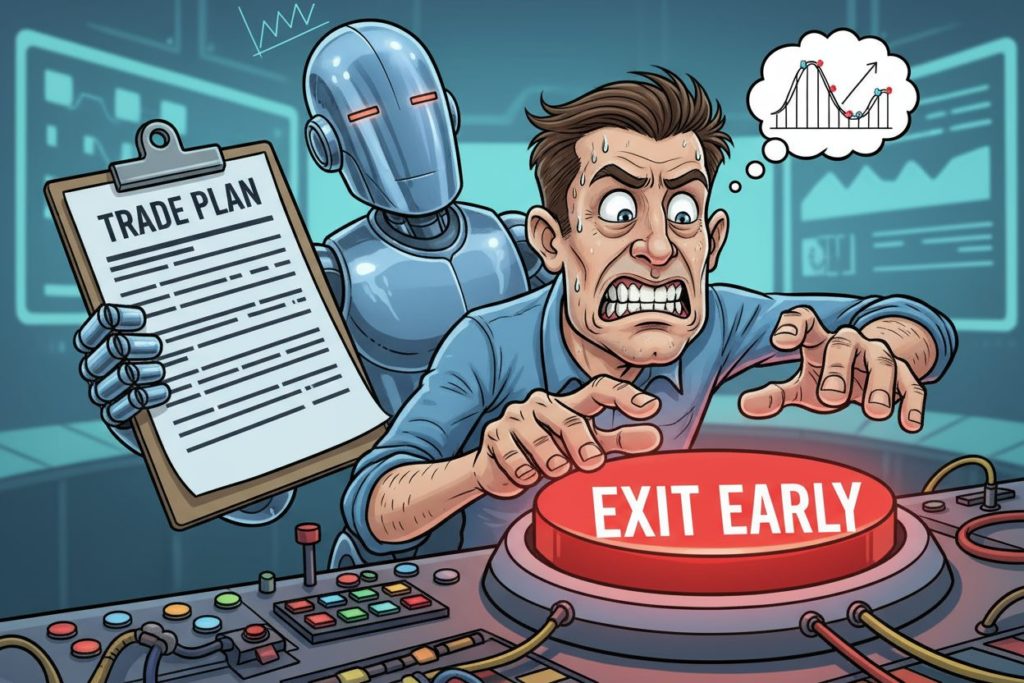

False Breakouts Avoidance
Most traders get caught chasing breakouts that were never real to begin with. And listen… you’re never going to avoid all false breakouts…
The trick is patience; let the market show its cards. Let the price move dictate your next play.
Wait for your filters to be met on the higher time frame, whether that’s NR7 or some other observation.
Does the ORB strategy work in Forex?
Now, of course, FX is slightly different, right? Unlike the stock markets, there’s no open as such.
DAX and FTSE open at 8am GMT
Nasdaq and Dow open at 9.30am EST
You get the idea.
But with no ‘open’, how do you trade the ORB strategy in forex?
Well, you have a few options.
- Replicate the opening times for the underlying market. So if you’re trading a USD pair you look at the NYSE open time and use that. EURO – Dax, GBP – FTSE, JPY – Nikkei, etc…
- Use the Asian, London or US sessions as markets to bracket the ORB – So for the London session you might use the 7.30-8 am candle and work off that.
I sound like a broken record here but experiment, see what works and build a strategy around that
(The below screenshot is my ‘Exchange Eye indicator’ to help you visualise the sessions more clearly.)
Free download from TradingView here. (full opening range indicator below, too if you’re interested)


Opening Range Breakout Indicator for Trading View
A while ago, I hired a coder to write an indicator for Trading View.
I wanted it so that I could map out the price movements on the chart nice and clearly. See where the stop loss would go, and be able to use the strategy feature in Trading View to backtest different settings (like stop loss distance, trigger parameters or even taking the opposite side of the ORB with fade mode)
It’s pretty decent, and a nice way to work through your opening range breakout strategy ideas.
Great for you visual traders.
Check it out, it’s free 👉🏻 ORB Tool. (Already downloaded by 1000s of traders – screenshots below)








Traders Also Ask...
How can I improve the opening range breakout strategy?
We know that the ORB strategy gets killed in choppy, directionless price action.
So the number one factor for improving your average profit is to identify markets that have decent trading activity, and more likely to carry on the move in the breakout direction. Easier said than done!
But here are some ideas:
Trading the ORB strategy after a narrow range day.
Volatility expands and contracts in the market. If you’ve had a narrow range day (like a NR7) then you are speculating on the range expanding again.
And the ORB works best in range expansions.
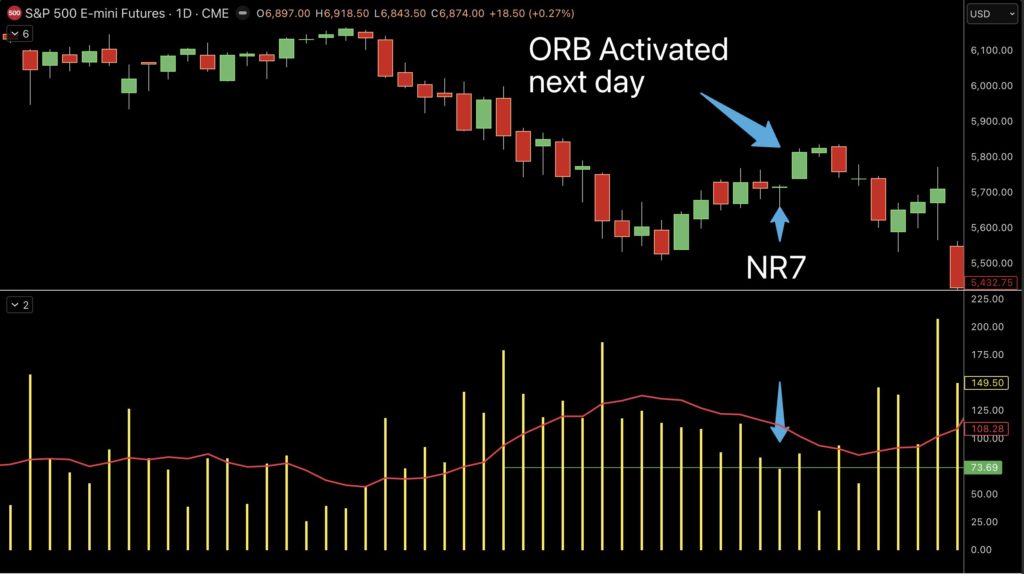

Only trading the price breakout in the direction of the daily trend.
They say a rising tide lifts all ships…
If the market is in a strong trend on the daily time frame, you could consider only taking opening range breakout trades in the direction of that trend to avoid false breakouts.
eg:
- Daily uptrend = Long ORB only
- Daily downtrend = Short ORB only
- Range-bound daily = Both
Trading ORB when there’s been a gap or news event.
Gaps can be an indication of institutional activity. Traders may be reacting to news, which could cause increased volatility.
Higher time frame traders wait for news and data to initiate positions. So, we can use gaps as a reference point to consider initiating an opening range breakout trade
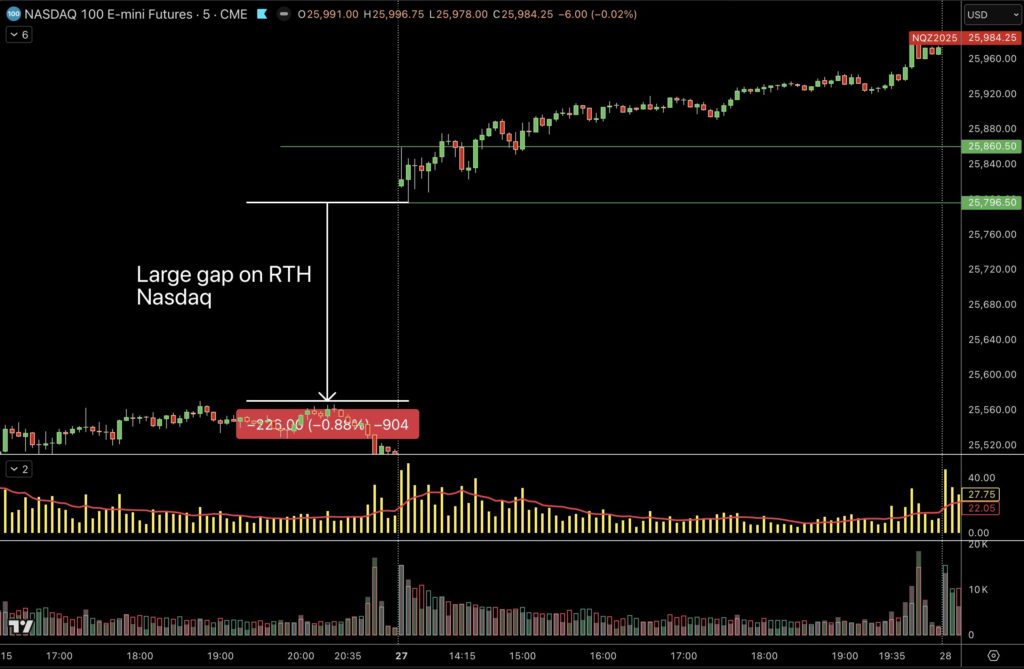

What is the best timeframe for opening range breakout?
There’s no one-size-fits-all answer.
Some traders swear by the 5-minute range, others prefer 15 or even 30
The best thing you can do is test it… see which timeframe gives you cleaner breaks and fewer fakeouts in the markets you trade. (because it’s very market-dependent)
Use a journal or backtest tool to log results over a few weeks… patterns appear fast once you start tracking.
And if you want a shortcut, check out the ORB Indicator above; it automatically plots the ranges so you can focus on reading the reaction, not drawing boxes.
How profitable is the Opening Range Breakout Strategy? (Backtest)
Jarrod Goodwin backtests various different opening range breakout strategy scenarios using Toby Crabel’s ORB research.
Many of the Forex pairs he tested yielded consistent profits. He also shares with traders that the profit factor is very much dependent on the stop loss settings used.
How do you confirm opening range breakout strategy?
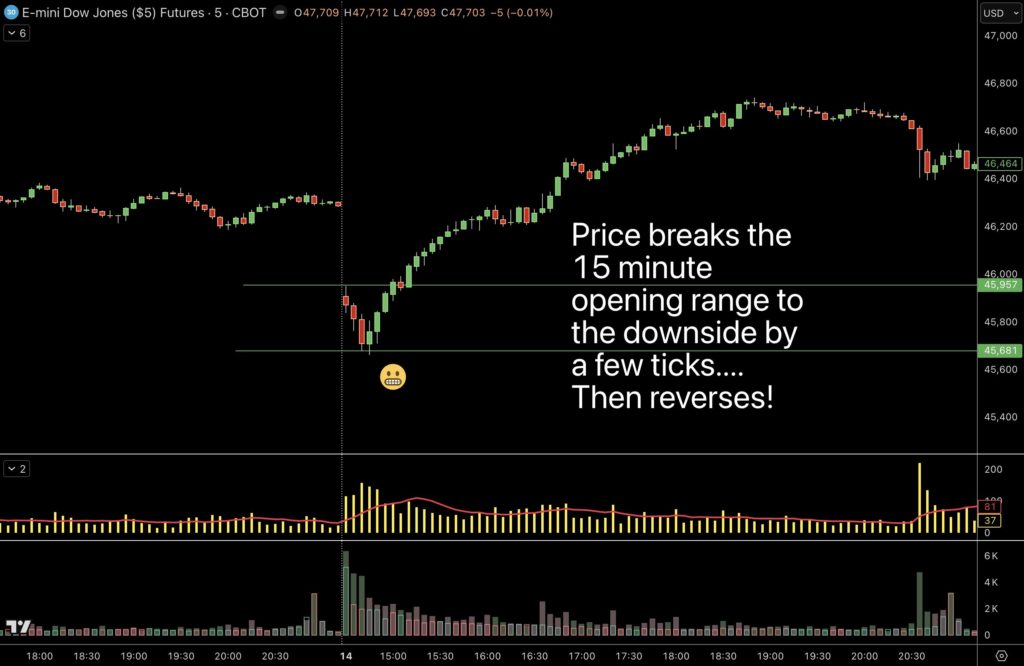

The ‘textbook’ says to initiate a trade as soon as price breaks the opening range high or low (your chosen time frame)
But sometimes it’s better to wait for the bar to close above or below the opening range before entering the trade to avoid false signals…
Of course, nothing is perfect. Some days waiting for a candle close will pay off, as the market breaks then whips back on the opposite direction.
Others it won’t… and your entry will be very late.
Experiment, play around, see how things play out.
Before you go day trading opening range breakout...
Here are some more links that might interest you.
Firstly, links to developing trader podcast episodes.
1 – The opening range breakout specialist – This trader only trades ORB.
2 – Trading the Asian session breakout (Forex trader) – Not strictly ORB but a variation of a range breakout.
Also, if you want to explore more old school trading strategied, then check out The Simplified Guide to trading the Wyckoff method.
Or click here to dig into a buffet of setup ideas! Trading strategies for active traders.
